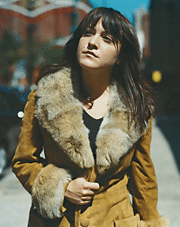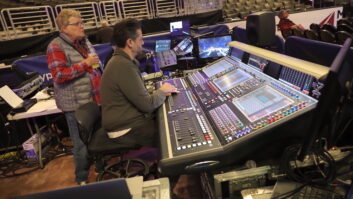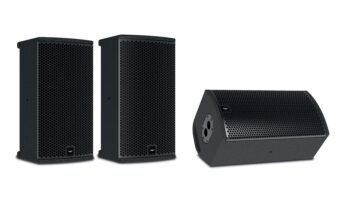
photo: Jan Welters
It is the rare French act that makes waves in the U.S.; in recent years, only the Afro-French hip hop sister act Les Nubians created much of a stir. But the folkish Paris-based singer/songwriter known simply as Keren Ann has insinuated herself into the American music scene in a different way: by spending months at a time living in New York and writing and singing songs in English and French. In 2003, her English-language debut on Blue Note’s Metro Blue imprint, Not Going Anywhere, drew critical raves, respectable sales and led to full houses at the Manhattan clubs she haunts when she’s in town. Her latest CD, Nolita (after her New York neighborhood, “North of Little Italy”), is filled with impressions of her adopted second home, along with musings on relationships and life in general, sung in English and French. Keren Ann has a fragile soprano that at times recalls American influences such as Joni Mitchell and Suzanne Vega, but also feels like it’s part of a grand tradition of breathy French singers, from Françoise Hardy to Jane Birkin, who seem to be whispering directly into the ear of the listener, using the song as an intimate confessional. Her songs can seem disarmingly simple, yet they are more complex than they appear, and the arrangements frequently progress in unusual ways as the songs build.
Keren Ann’s first three albums — two French discs and Not Going Anywhere — were collaborative efforts with French producer/writer/multi-instrumentalist Benjamin Biolay. His imaginative stamp is all over those discs. On Nolita, however, Keren Ann was the driving force in every respect, and she’s clearly learned much from being at Biolay’s side. She wrote the songs, produced the album, played many of the instruments (multiple guitars, keyboards, programming) and even did much of the engineering, often working alone at home, recording to Pro Tools in her apartment in the Montmartre section of Paris and then later in her Nolita studio.
The daughter of a Javanese-Dutch mother, a Russian-Israeli father, and raised in Paris since the age of 11, Keren Ann Zeidel started recording her songs long before she had a label deal. “When I was a teenager, I had a Tascam 4-track and I’d make tapes of my songs,” she says in her precise, lightly accented English. “Later on, I got an 8-track but I kept the 4-track, and I still sometimes use it as a preamp because I like the sound of it. Then, I got the Roland digital 16-track, and from there I went to Cubase and then I moved on to Pro Tools MIXPlus, with the Mackie board I’ve had for a quite a while. I will never be an amazing technical engineer who knows how to get any sound, but I do know what I want to hear, and when I don’t know how to get it, I work with an engineer. But in terms of recording instruments, like strings and trumpets and guitars and keyboards and my vocals, I can pretty much get what I’m looking for through my preamps or compressors. I also like to use a lot of guitar pedals to get interesting sounds.
“My favorite preamp is the D.W. Fearn [VT-1]; I’ve always recorded my vocals through that and a Neumann U87. For guitars, I usually rent a U47 while I’m recording; those are my two favorite mics. Depending on the song, I’ll go direct or maybe through the amp only, or through pedals. When I’m recording electric guitar, I use this great old 1967 Chet Atkins Gretsch that I love.”
Keren Ann usually records her own voice and guitar demos, then starts methodically building tracks. On Nolita, bass and drum basics were mostly recorded by engineer Bruno Dejarnac at Studio Deux, a small studio outside of Paris. Then the action shifted to her Paris apartment studio setup, which she calls Studio Philipsen, named after her grandmother. “It’s very small, but I have a great view and I love the way it sounds, so I left the walls and ceilings as they were. I’m very comfortable working there.” Occasionally working with engineer Hubert De Cottignies, Keren Ann tracked the layered string parts, which are so striking on the title track: Although it’s just a cello and violin, it sounds like a full string section. “I always work out the string parts on a keyboard and then someone writes it,” she notes. “Nolita took a long time to do.”
In February 2004, during a trip to New York, Keren Ann found the Nolita loft/workspace that she would transform into the studio she dubbed Yellow Tangerine. She booked it for six months beginning in June and shipped the gear from her Paris studio. She still spent most of her time in New York recording alone, but she also brought in a couple of local players, including a guitarist named Jack Petruzzelli, who added some wonderfully moderne parts and ambient electronics to a few tracks, and trumpeter Avishai Cohen.
Asked about the intriguing ambient noise tracks that creep quietly through a few songs on the album, she laughs and says, “Sometimes it’s just for mood, but sometimes it’s to cover up the noise of New York or Paris. I like to record ambiences in places. Like in ‘Chelsea Burns,’ there’s some New York in the background. That will happen in a home studio in a city.”
Another striking aspect of the album is Keren Ann’s intricately layered background vocals, which range from simple harmonies to elaborate choral washes, as on the song “Greatest You Can Find.” “On that one,” she says, “the song was starting to bore me and I needed to change it. First, I thought I wanted horns on the ending, but I didn’t have the opportunity to have horns, so I did it with the voice instead, but it’s almost like a horn part. Since I have the time and I have my own setup, I can try things that are ridiculous and play around with them.”
As with Keren Ann’s other albums, Nolita was mixed on a mid-’70s Neve console at ICP Studios in Brussels, Belgium, by Erwin Autrique. “He’s so fantastic,” she says. “He’s familiar with the way I work and he can understand my notes, my tapes or Pro Tools files, and he knows how to read me. And he makes everything sound bigger. On my own, I tend to make things moody in my choice of sounds rather than big. But on certain things, like the guitars, I want him to take them further and make them bigger. He always seems to understand what I’m after.”






